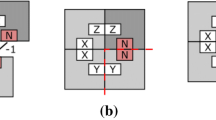Abstract
Self-assembly is a process in which small building blocks interact autonomously to form larger structures. A recently studied model of self-assembly is the Accretive Graph Assembly Model whereby an edge-weighted graph is assembled one vertex at a time starting from a designated seed vertex. The weight of an edge specifies the magnitude of attraction (positive weight) or repulsion (negative weight) between adjacent vertices. It is feasible to add a vertex to the assembly if the total attraction minus repulsion of the already built neighbors exceeds a certain threshold, called the assembly temperature. This model naturally generalizes the extensively studied Tile Assembly Model. A natural question in graph self-assembly is to determine whether or not there exists a sequence of feasible vertex additions to realize the entire graph. However, even when it is feasible to realize the assembly, not much can be inferred about its likelihood of realization in practice due to the uncontrolled nature of the self-assembly process. Motivated by this, we introduce the robust self-assembly problem where the goal is to determine if every possible sequence of feasible vertex additions leads to the completion of the assembly. We show that the robust self-assembly problem is co-NP-complete even on planar graphs with two distinct edge weights. We then examine the tractability of the robust self-assembly problem on a natural subclass of planar graphs, namely grid graphs. We identify structural conditions that determine whether or not a grid graph can be robustly self-assembled, and give poly-time algorithms to determine this for several interesting cases of the problem. Finally, we also show that the problem of counting the number of feasible orderings that lead to the completion of an assembly is #P-complete.











Similar content being viewed by others
References
Angelov S, Khanna S, Visontai M (2008) On the complexity of graph self-assembly in accretive systems. Nat Comput 7(2):183–201
Chelyapov N, Brun Y, Gopalkrishnan M, Reishus D, Shaw B, Adleman LM (2004) DNA triangles and self-assembled hexagonal tilings. J Am Chem Soc 126(43):13924–13925
Chen H-L, Goel A (2004) Error free self-assembly using error prone tiles. In: Proceedings of the 10th international workshop on DNA computing, pp 62–75
He Y, Chen Y, Liu H, Ribbe AE, Mao C (2005) Self-assembly of hexagonal DNA two-dimensional (2D) arrays. J Am Chem Soc 127(35):12202–12203
LaBean TH, Yan H, Kopatsch J, Liu F, Winfree E, Reif JH, Seeman NC (2000) Construction, analysis, ligation, and self-assembly of DNA triple crossover complexes. J Am Chem Soc 122(9):1848–1860
Lichtenstein D (1982) Planar formulae and their uses. SIAM J Comput 11(2):329–343
Malo J, Mitchell JC, Vénien-Bryan C, Harris JR, Wille H, Sherratt DJ, Turberfield AJ (2005) Engineering a 2D protein-DNA crystal. Angew Chem Int Ed 44(20):3057–3061
Middleton AA (1999) Computational complexity of determining the barriers to interface motion in random systems. Phys Rev E 59(3):2571–2577
Reif JH, Sahu S, Yin P (2005) Complexity of graph self-assembly in accretive systems and self-destructible systems. In: Proceedings of the 11th international meeting on DNA computing, pp 101–112
Rothemund PWL (2000) Using lateral capillary forces to compute by self-assembly. Proc Natl Acad Sci USA 97(3):984–989
Rothemund PWK, Winfree E (2000) The program-size complexity of self-assembled squares (extended abstract). In: Proceedings of the 32th annual ACM symposium on theory of computing, pp 459–468
Rothemund PWK, Papadakis N, Winfree E (2004) Algorithmic self-assembly of DNA Sierpinski triangles. PLoS Biol 2(12):2041–2053
Schnyder W (1990) Embedding planar graphs on the grid. In: Proceedings of the 1st annual ACM-SIAM symposium on discrete algorithms, Philadelphia, PA, USA. Society for Industrial and Applied Mathematics, pp 138–148
Valiant LG (1979) The complexity of computing the permanent. Theor Comput Sci 8:189–201
Wang H (1961) Proving theorems by pattern recognition II. Bell Syst Tech J 40:1–41
Winfree E, Bekbolatov R (2003) Proofreading tile sets: error correction for algorithmic self-assembly. In: Proceedings of the 9th international workshop on DNA based computers, pp 126–144
Winfree E, Liu F, Wenzler LA, Seeman NC (1998) Design and self-assembly of two-dimensional DNA crystals. Nature 394:539–544
Yan H, LaBean TH, Feng L, Reif JH (2003) Directed nucleation assembly of DNA tile complexes for barcode-patterned lattices. Proc Natl Acad Sci USA 100(14):8103–8108
Author information
Authors and Affiliations
Corresponding author
Additional information
A significant portion of this work was done while the first author was at the Department of Computer and Information Science, School of Engineering and Applied Sciences, University of Pennsylvania.
Rights and permissions
About this article
Cite this article
Angelov, S., Khanna, S. & Visontai, M. Robust self-assembly of graphs. Nat Comput 9, 111–133 (2010). https://doi.org/10.1007/s11047-009-9149-5
Published:
Issue Date:
DOI: https://doi.org/10.1007/s11047-009-9149-5




